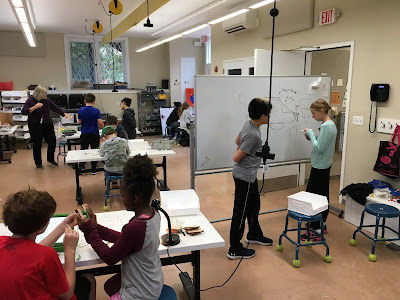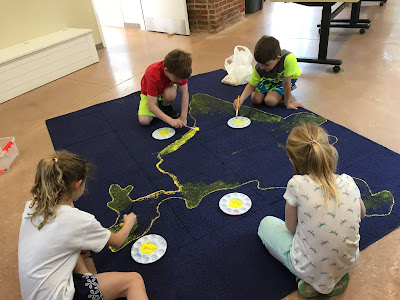September in the Light Lab is normally the quietest time of year as classroom teachers build community, set norms, and practice everyday routines in their own spaces. While they are busy setting their kids up for a successful year, I focus my extra time on organizing, ordering, planning calendars, and developing project ideas that will eventually take shape in one of the four maker studios.
This October marks the second anniversary of the opening of the Ulmer Family Light Lab, and this September could not be described as quiet. This Makerspace Director was thrilled to have joyful voices and busy hands in the building from the very first day of school.
Several grades have major projects already underway or most of the way through the planning stages:
Fifth graders finished an engaging goal-writing assignment paired with Scratch programming to animate their academic and social goals. They used a single point rubric to monitor their progress through the three week project. They participated in a peer gallery walk before the final work sessions to gather feedback and apply final changes. Teacher Christie and I will complete our assessment of their program this week using the same rubric.
Nursery visited the Natural Sciences Studio to chop apples for homemade applesauce. While it cooked, we learned a little bit about the legend of Johnny Appleseed. The warm applesauce was yummy on a brisk fall day.
Nursery visited the Natural Sciences Studio to chop apples for homemade applesauce. While it cooked, we learned a little bit about the legend of Johnny Appleseed. The warm applesauce was yummy on a brisk fall day.
Fifth graders are also beginning their first building session as they focus on green energy and sustainability. Each group selected either solar, wind, or water power. They will design and build a working energy model which is connected to their study of society and civilizations. More on this soon!
Grades 1, 3, and 4 became aeroponic tower stewards. In preparation for a new aquaponic system (with fish!), we moved two towers from the solarium into the cafeteria where they will be monitored by first and fourth graders weekly. The remaining tower, managed by third grade, is now located on the third floor near the elevator. Since the towers are receiving less sunlight, we added grow lights. The first leaf lettuce was harvested and enjoyed by fourth graders on Friday.
Both Kindergarten classes brought their mathematicians and readers into the Lab to put their skills to good use. KA made their very own ice cream shop to buy and sell their homemade sweet treat while practicing money skills. KB builders explored ramps and structures while working on their custom super hero capes that will celebrate their mastery of reading skills.
Both Kindergarten classes brought their mathematicians and readers into the Lab to put their skills to good use. KA made their very own ice cream shop to buy and sell their homemade sweet treat while practicing money skills. KB builders explored ramps and structures while working on their custom super hero capes that will celebrate their mastery of reading skills.
Third graders took a tour of each studio to open their minds to all the tools and materials available. They explored how electricity travels by building circuits with LittleBits. They loved these cool prototyping materials! 3A decided to spend the next few weeks making cardboard creations that they will wire with simple electronics to light, move, or buzz something.
The entire division participated in the annual Harvest Festival by sampling soup made from our FCS garden ingredients, cutting veggies, and gathering in the courtyard for the cherished tradition a Stone Soup reading by our seniors. The weather couldn't have been more beautiful as we enjoyed each other's company and sipped mint tea made by Sarah Taylor and our PK/K classes. Special thanks for Tiffany Borsch for organizing and leading this amazing celebration of sustainability, gardening, and outdoor learning.
1B will begin assembling working water wheels with their buddies this week. They are using everyday materials like tin pie pans, tape, and coat hanger wire to make each wheel. Using hammers and drills, they will assemble a sturdy wooden base. We are hoping to make a larger version of these personal sized wheels later this year for the lower playground space.
The new addition of fourth and fifth grade electives gave me the chance to offer an introductory Arduino class for students interested in learning how to breadboard, build electronics, and code in the Arduino language (based on C). We spent the first half of our sessions learning the components, following schematics to build models, and altering the code offered through the Arduino text editor. This week, we will take a closer look at a few creative projects we could build together in our remaining time.
Fall Clubs are underway in the Light Lab with Coding Cafe on Tuesday afternoons. Ms. Borrero's coders have been working in Scratch to make programs that fulfill specific coding criteria while allowing lots of creative design freedom. I had the chance to see some of these programs; I was very impressed with the advanced programming concepts being used successfully - lists, conditionals, and functions. Awesome.
Cooking Club has been delicious! Aspiring chefs are learning how to cook and bake by focusing on recipes and methods that can be repeated at home. We've learned how to cook all kinds of eggs (and by doing so, learned which kinds of eggs we like to eat), made moist banana bread loaves, and blended up creamy hummus. Many families have been enjoying their child's increased interest in cooking at home.
Fall has certainly been productive and joyful. The Light Lab studios have not only been full of kids working happily on hands-on projects; many adults have utilized the spaces for parent socials, school events, and maker activities that support our community. It's wonderful to see this resource grow and expand to fill the needs of our Lower School community members.
Tune in again soon as we explore methods for assessing Maker Ed projects this year. This topic is one that is being widely discussed in the Maker Ed world. We are piloting some new ideas that we hope will add to the growing dialogue.
1B will begin assembling working water wheels with their buddies this week. They are using everyday materials like tin pie pans, tape, and coat hanger wire to make each wheel. Using hammers and drills, they will assemble a sturdy wooden base. We are hoping to make a larger version of these personal sized wheels later this year for the lower playground space.
The new addition of fourth and fifth grade electives gave me the chance to offer an introductory Arduino class for students interested in learning how to breadboard, build electronics, and code in the Arduino language (based on C). We spent the first half of our sessions learning the components, following schematics to build models, and altering the code offered through the Arduino text editor. This week, we will take a closer look at a few creative projects we could build together in our remaining time.
Fall Clubs are underway in the Light Lab with Coding Cafe on Tuesday afternoons. Ms. Borrero's coders have been working in Scratch to make programs that fulfill specific coding criteria while allowing lots of creative design freedom. I had the chance to see some of these programs; I was very impressed with the advanced programming concepts being used successfully - lists, conditionals, and functions. Awesome.
Cooking Club has been delicious! Aspiring chefs are learning how to cook and bake by focusing on recipes and methods that can be repeated at home. We've learned how to cook all kinds of eggs (and by doing so, learned which kinds of eggs we like to eat), made moist banana bread loaves, and blended up creamy hummus. Many families have been enjoying their child's increased interest in cooking at home.
Fall has certainly been productive and joyful. The Light Lab studios have not only been full of kids working happily on hands-on projects; many adults have utilized the spaces for parent socials, school events, and maker activities that support our community. It's wonderful to see this resource grow and expand to fill the needs of our Lower School community members.
Tune in again soon as we explore methods for assessing Maker Ed projects this year. This topic is one that is being widely discussed in the Maker Ed world. We are piloting some new ideas that we hope will add to the growing dialogue.




















































